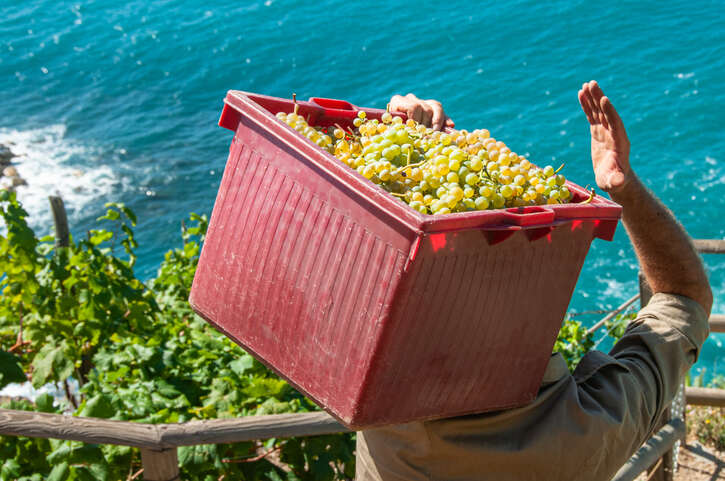
Despite difficult growing conditions, global wine production in 2021 was not as bad as previously feared, with annual production just slightly lower than in 2020.
The newest data on 2021 global wine production and consumption, announced on Thursday by Pau Roca, the Director General of the International Organisation of Vine and Wine (OIV), also showed that global wine consumption in 2021 showed partial recovery from the pandemic, and that international exports of wine have grown, especially in value.
Global wine production in 2021
In November, the OIV warned that the extreme weather affecting Europe could lead to the lowest wine production seen in 30 years.
However the updated figures published today assuage those fears, showing global wine production of 260mhl, just 1 percent lower than in 2020 and 2 percent below the five-year average.
The reason for this re-calculation was largely due to France and Italy: At almost a fifth below 2020 levels, France’s decline in wine production caused by the late frosts in April 2021 was still significant, but not as severe as the 26 percent drop initially predicted.
Meanwhile, Italy forecast its wine production would be 9 percent lower than in 2020, but it in fact ended up being 50.2 mhl, slightly above the 2020 level.
Overall, the EU27 had forecast a 13 percent decline in annual production, but the updated figures place the total at 153.7mhl, 8 percent below 2020 levels.
Australia, Chile, Brazil, and Argentina all saw significant increases in their annual production, after the last few years of difficult growing conditions.
However, early estimates from the Southern Hemisphere suggest that New World wine production in 2022 will tend back towards the average production after their 2021 gains, with Argentina, Australia, and Chile all seeing significant annual falls in production of around 10 percent.
Global wine consumption in 2021
In 2021, global wine consumption saw a slight recovery from the dip of 2020 up to 236 mhl. The lifting of Covid restrictions in much of the world amounted to annual growth of around 1 percent, but still 2 percent below the average of the previous five years.
In particular, France and Spain saw significant increases in national consumption, with Spain bouncing back from a 7 percent fall in consumption in 2020.
Meanwhile China’s annual consumption continued its pattern of decline, while Argentina’s 2021 fall is likely due to a surprising spike the previous year.
Global wine trade and exports in 2021
Between the years 2000 and 2011 the wine trade rapidly internationalized, the volume of wine exported annually growing over 40 per cent within the decade. Since then, the trend has leveled off at around 105-110 mhl exported globally per year.
But while the volume has stayed steady, over the past decade the value of wine exported has grown significantly: in fact since 2011, even though the volume of wine hasn’t grown much, the total value of wine exported has grown by over 50 percent, up to more than €30 billion per year.
In 2021, the global volume of wine exported grew by 4 percent, but the value grew by 16 percent, showing a tendency towards higher-priced, high-quality wines. This trend is also reflected in the growth in value and volume of bottled wines, rather than cheaper bulk or bag-in-box (BiB) wines.
Most noticeably, the recommencement of weddings and other celebrations after the pandemic can be seen in the huge growth of sparkling wine exports.
While the segment took a fair dip in 2020 due to the lockdown, this has been more than surpassed in the past year, with sparkling wine exports totaling over €7.5 billion.
This tendency towards higher-value wines is one that can be seen globally, out of every major wine exporter, Australia is the only one who saw the total volume and value of wine exports fall, due to the rise in Chinese tariffs put in place last year.
While some countries—USA, Argentina, and New Zealand—have seen the volume of exports fall as compared to 2021, they have still seen the overall value grow, as consumers tend towards bottled wine and higher-value wine.
Meanwhile, the biggest import increases come from the USA—which increased the volume imported by 13 percent and the value imported by 21 percent—and Italy, which saw olumes of bulk wine almost double.
Germany and the UK are alongside the USA as the world’s biggest wine importers, and both countries saw the value of wine imported increase, while volume decreased or stayed level.
The past two years have shown the wine sector’s resilience, Roca said, as it adapted to the pandemic and closure of hospitality and tourism with a strong pivot to e-commerce.
Now, he says, the wine sector faces a new challenge in the global supply chain, with shortages and rising prices in materials, labor, and energy.
“Following 2020, a year of crisis, in 2021 we saw an overall recovery of the wine market,” Roca said. “Now the real challenge is to see how the sector will face up to the new situation in 2022.”






